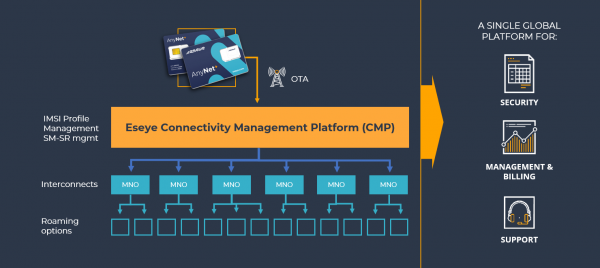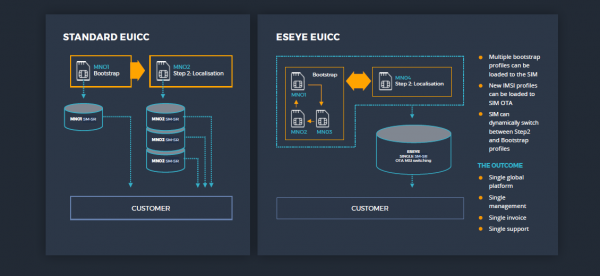Blogs
21 July 2020
Reading Time: 3 mins
Blogs
21 July 2020
Reading Time: 3 mins

Eseye
IoT Hardware and Connectivity Specialists
LinkedInOver the last two blogs, we explored What is a Multi-IMSI SIM and What is eUICC. We uncovered their differences, strengths and potential for commercial IoT but also exposed their weaknesses too. In the third part of our IoT Uncovered series, we’ll reveal how businesses can overcome the risks caused by the eUICC standard and the solution needed to supercharge eUICC for commercial IoT projects.
For the best connectivity, IoT deployments require purpose-built multi-IMSI SIMs. They should have the intelligence to operate both autonomously and in conjunction with a connectivity management platform to ensure devices are always connected to the best available network.
IoT SIMs should be eUICC-compliant to ensure that you can swap network providers if required, which also future-proofs your IoT deployment too.
“The move to eUICC helps to remove another barrier for IoT adoption. It makes it simpler for enterprises to add connectivity to devices, and then to manage those connections. This should help enterprises in a number of ways including by increasing flexibility and lowering costs”. – Tom Rebbeck, IoT Research Director at analyst firm Analysys Mason
The problem is that the large majority of IoT eUICC SIM solutions adopt a single global bootstrap approach, which is unable to offer high levels of global network connectivity and removes any fallback options once an over-the-air (OTA) network change is instigated. This dramatically increases the risk that some devices would be unable to connect on deployment.

Since 2007, Eseye has led the way in IoT connectivity.
In 2013 we launched the world’s first intelligent multi-IMSI SIM technology remote provisioning using full network profiles (comparable to the eUICC SM-SR functionality).
Eseye now extends this solution to include full eUICC compliance with the AnyNet+ SIM – the world’s most advanced GSMA compliant eUICC SIM with in-built multi-IMSI switching technology.
Built to greatly improve global commercial IoT connectivity, this latest evolution of its AnyNet Secure SIM technology combines the best of Eseye’s multi-IMSI capability with the GSMA eUICC standard, offering IoT customers the most advanced solution on the market today.
The AnyNet+ SIM is available in both embedded eSIM and removable SIM form factors. And its unique design comes from multiple bootstraps (multi-IMSI), or network profiles. The SIM stores up to three IMSIs for bootstrapping and more can easily be uploaded over-the-air to improve localisation and resiliency.

This means that, when coupled with Eseye’s Connectivity Management Platform and an extensive list of network interconnects, the AnyNet+ SIM card can rotate between the bootstrap profiles to find optimum coverage on another network.
What’s more, it also features a two-way interchange between the bootstrap and the eUICC step 2 profile (which localises the SIM to the network) to enable a fallback capability. This interchange eliminates the risk and associated cost of the device being disconnected, enabling customers to meet local legislative requirements, such as those that ban permanent roaming, while accommodating for changes in the future regulatory landscape.

At the very core of the process is Eseye’s Subscription Manager Secure Routing (SM-SR). This fundamental SM-SR capability enables Eseye to deliver a secure, resilient and flexible solution with near 100% device connectivity globally.
“The AnyNet+ solution is a game-changer, ready to empower our customers to unlock the full potential of IoT by delivering near 100% connectivity – the highest quality of service available on the market today”.
Nick Earle, CEO, Eseye
Predictable performance is the key to IoT success. Let our experts test your device for free. Receive a free trial IoT SIM trial kit and speed up your IoT deployment with expert insights and seamless connectivity.